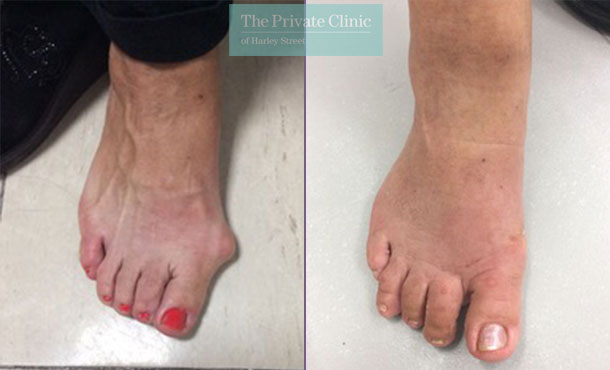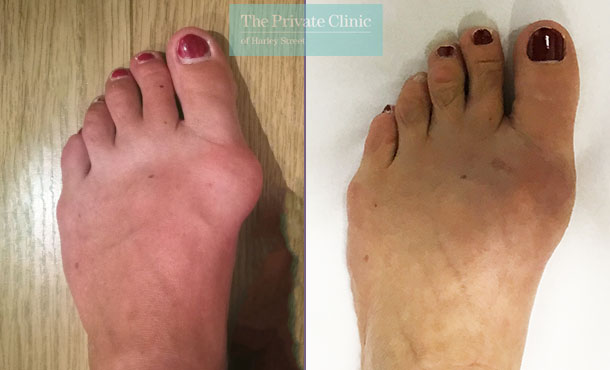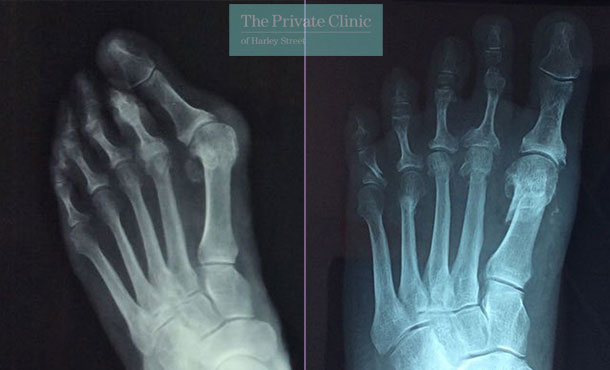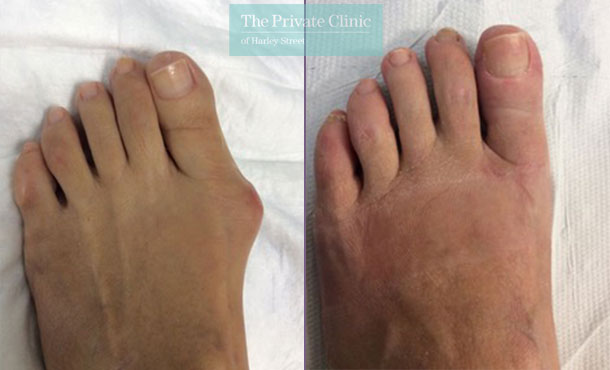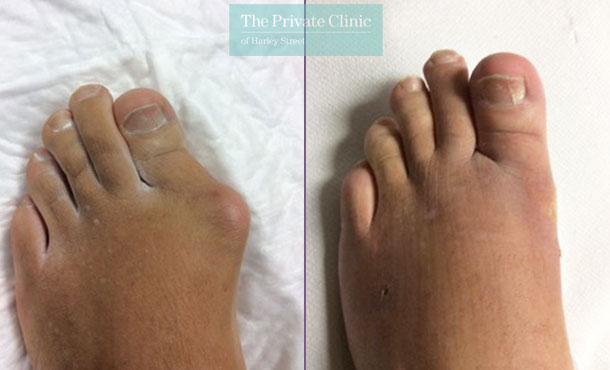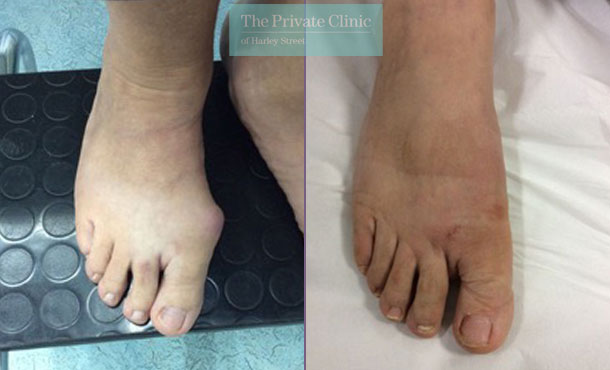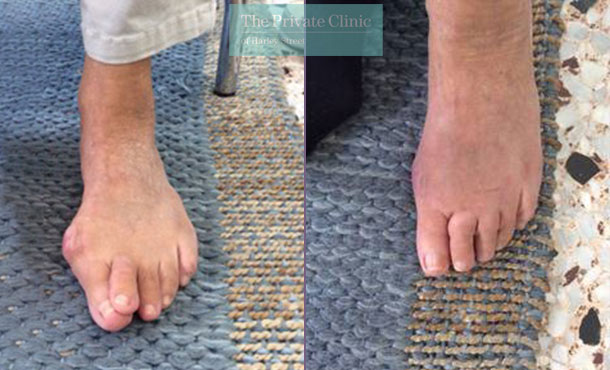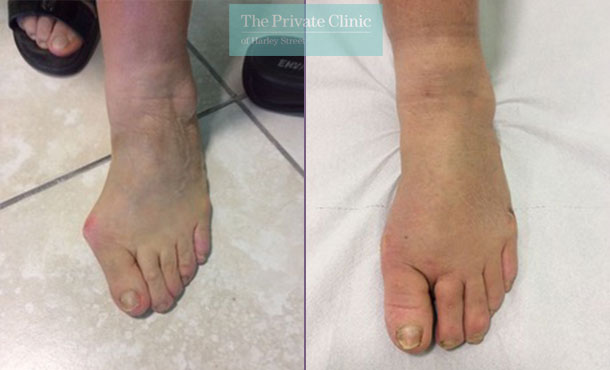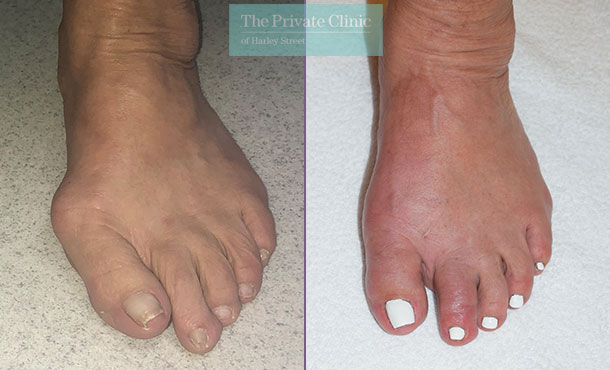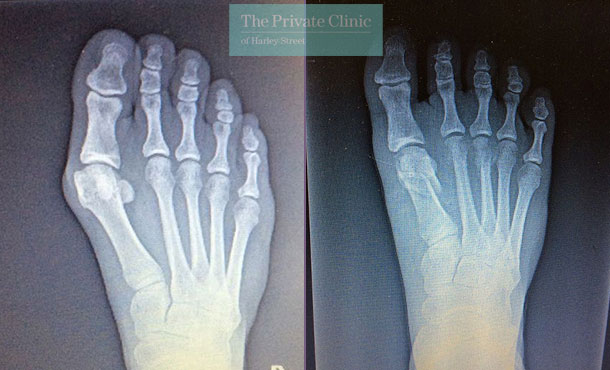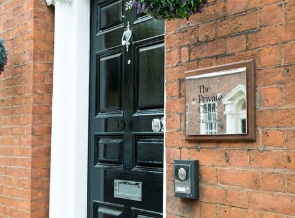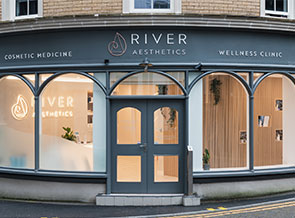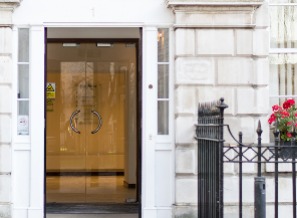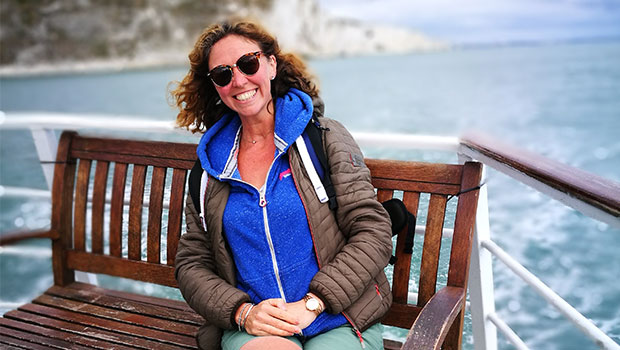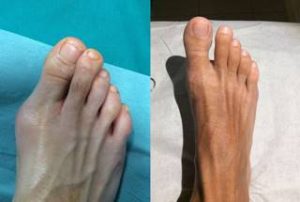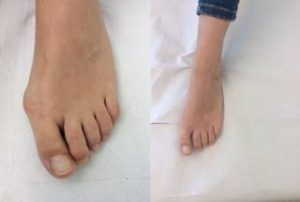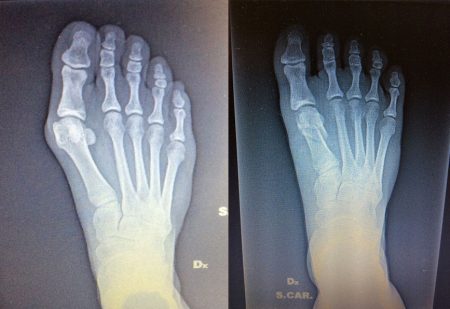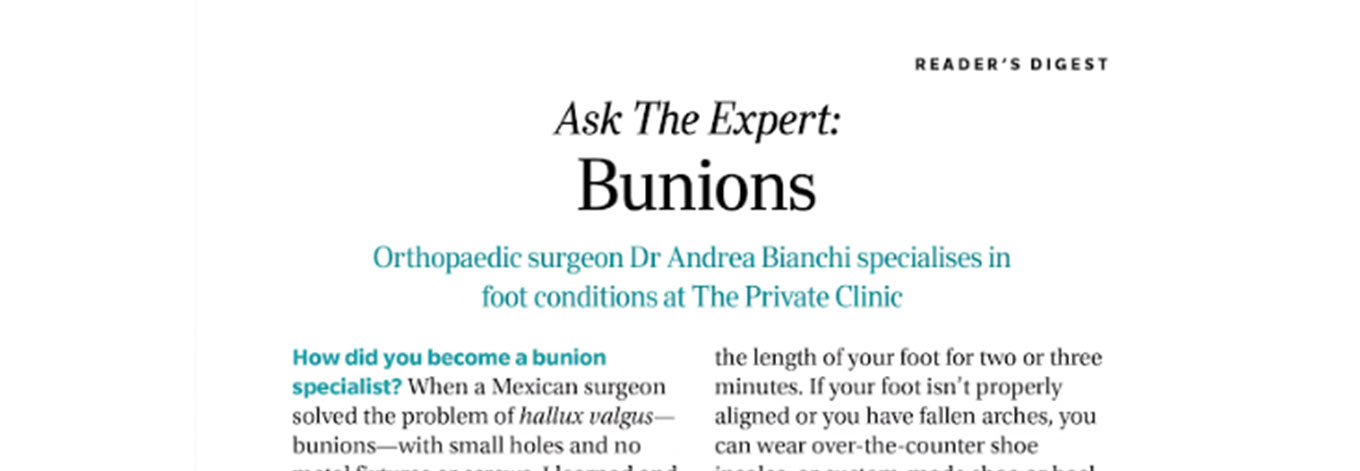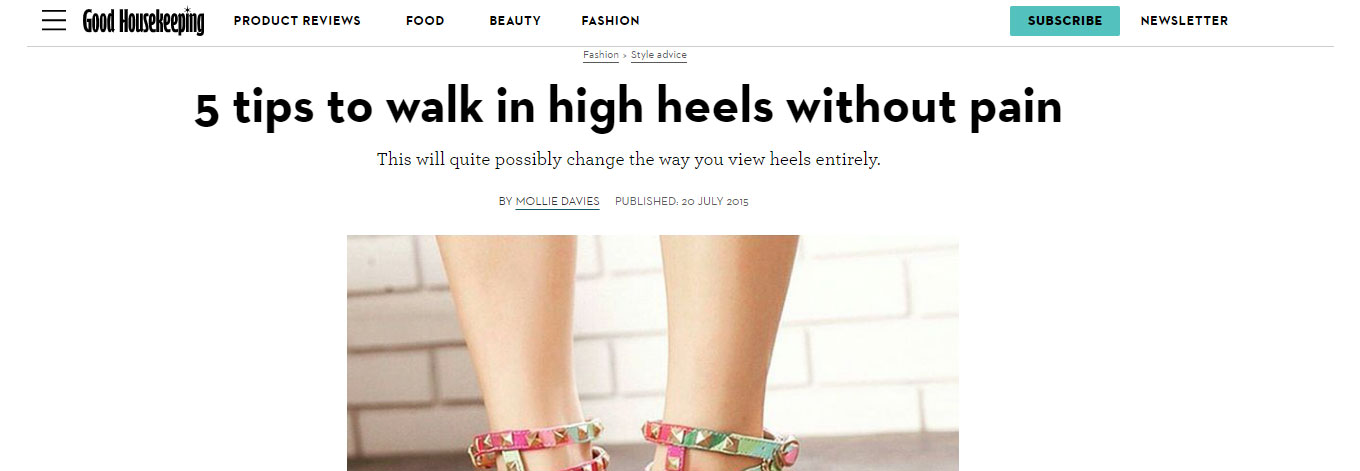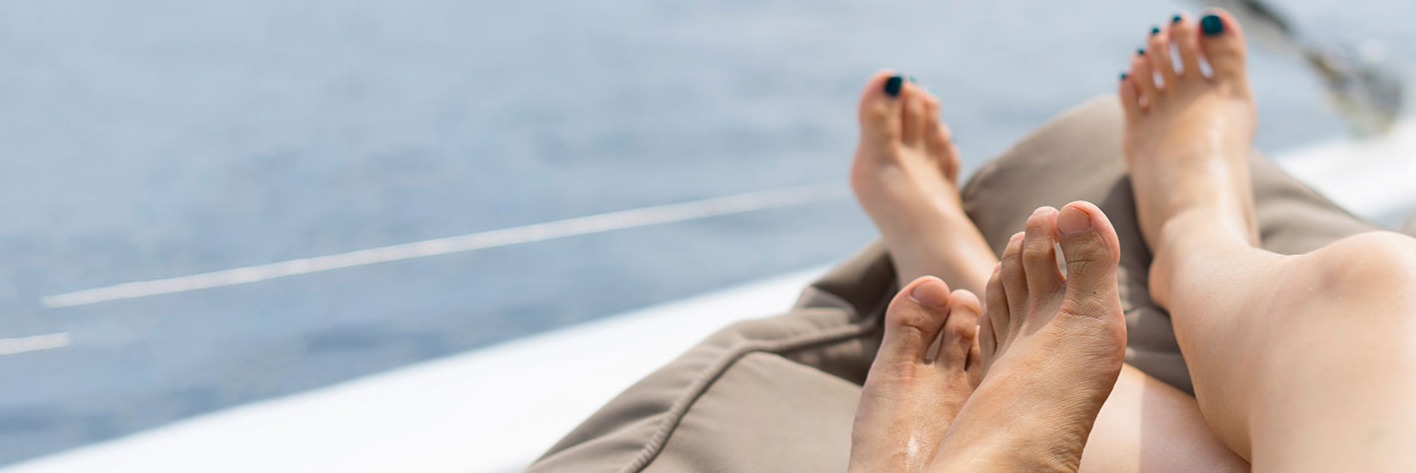
- Minimally invasive, day case Bunion removal surgery
- No crutches, no downtime, walk out of the clinic on the day
- Performed at Fitzroy Hospital in Central London
- 0% Finance Available
What’s on this page
- About this Treatment
- Before & Afters
- What to Expect
- FAQs
- Our Clinics
- Patient Stories
- Why the Private Clinic
- Meet the Surgeons
- Related Blogs & News
Medically reviewed by Mr Andrea Bianchi, Consultant Orthopaedic Surgeon for The Private Clinic of Harley Street, London.
Last Reviewed April 26th 2024
Related Treatments
Minimally Invasive Bunions Surgery
Day case Bunion treatment keyhole (Minimally invasive) surgery with no metal fixtures and no screws.
This treatment is exclusive to The Private Clinic.
For the majority of people who suffer from bunions, the downtime, metal fixtures and scars associated with bunions removal surgery is often not an option. At The Private Clinic, minimally invasive bunion surgery with no scar, no metal fixtures & no downtime is performed at our state of the art London Fitzroy bunion hospital by Consultant Orthopaedic Surgeon, Mr Bianchi, bunion specialists who pioneered this revolutionary procedure and has over 15 years of experience and performs 1,200 procedures each year.
5 Advantages of our unique bunion procedure over standard surgery
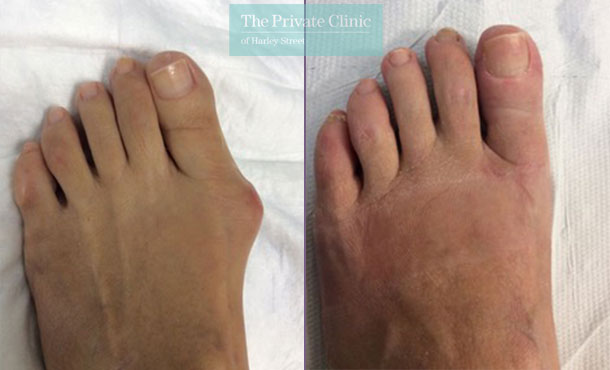
- No screws or fixtures. Avoid the potential complications that can arise from standard surgery. Without the use of any screws & fixtures, risks are significantly reduced.
- Be proud of your feet again. Our Keyhole method means you won’t suffer the significant scars seen with other methods so you can confidently wear the shoes you want.
- Return to daily activities sooner. Most patients can walk immediately following treatment without crutches & get back to their lives without the months of recovery required elsewhere.
- 98% success rate. Using his pioneering technique, our Consultant Orthopaedic Surgeon, Mr Bianchi arranges the toes with unrivalled precision for lasting results.
- No hidden costs. Aftercare and follow up appointments are integral to the success of your treatment so the price we quote includes these.
What are the advantages of the bunion surgery technique?
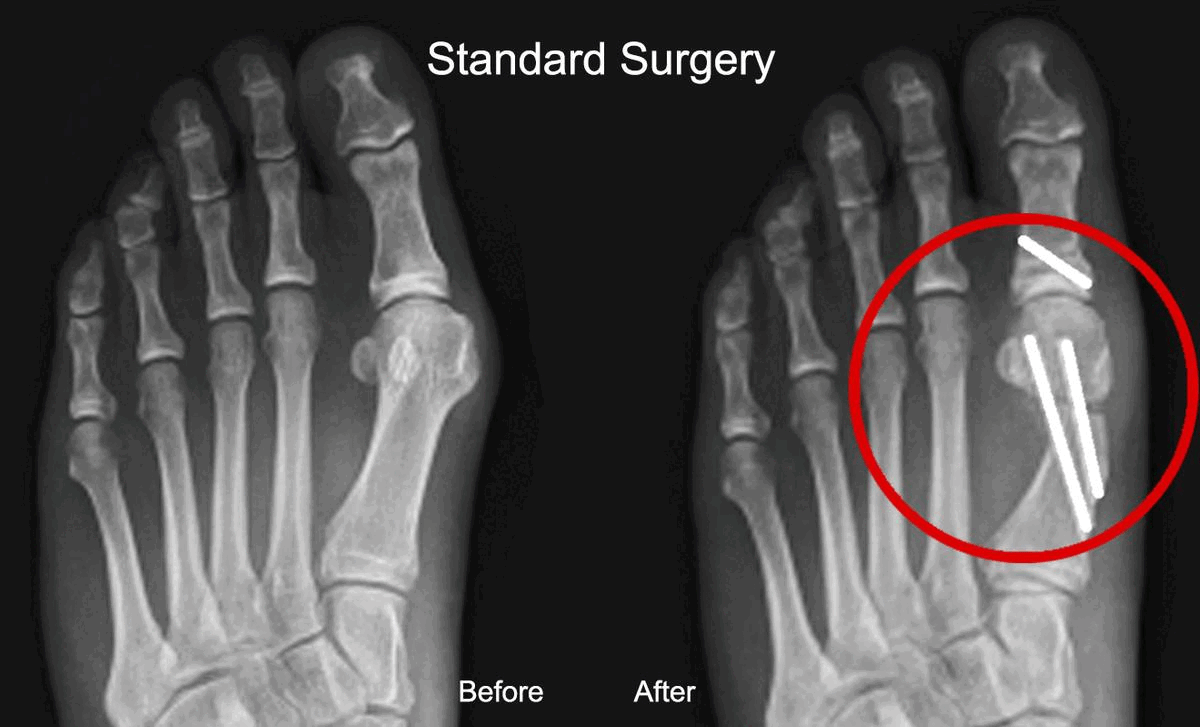
- The procedure is exclusive to The Private Clinic in the UK
- Performed by Mr Bianchi, the pioneer of this unique procedure
- Over 1200 procedures performed each year with a 98% success rate
- 5 star TrustPilot rating based on over 1700 reviews
- State of the art facilities and aftercare support
- No screws, plates, wires or metal fixtures required
- Keyhole surgery and no big scars
- No crutches, minimal downtime. Return to everyday activities quickly.
- Walk in walk out, minimally invasive day case procedure
Book a consultation at our London Harley Street Bunion Clinic, Manchester Bunion Clinic or Bournemouth Bunion Clinic to learn if you are suitable for bunion removal.
We also offer patient coordinator consultations for bunion correction surgery at our clinics in Birmingham and Northampton. These are great if you wish to find out more about the procedure and what is involved before meeting our Orthopaedic Consultant Surgeon.
Is Hammertoe or Tailor’s bunion Surgery available?
Bunion surgery or 3D laparoscopic bunion surgery may also be necessary if the big toe pushes into the second toe, causing a painful hammer toe. If you suffer from a bunion shape on the small toe (often called bunionette) we can help.
Consultant Orthopaedic Surgeon, Mr Bianchi treats hammertoe and tailors bunion with a similar method and includes all of the listed advantages. Please mention this when you book your consultation at our Manchester, Bournemouth or London Harley Street Bunion Clinics.
Download our brochure to learn more about minimally invasive bunion surgery at The Private Clinic, what is involved, what aftercare to expect and more.
“I am still amazed 4 weeks after op, how pain free and easy for me this procedure was. Mr Bianchi and his colleagues make you feel very comfortable and relaxed. I walked out after a couple of hours and carried doing what I do daily. Highly recommend Mr Bianchi and The Private Clinic.” – Lisa
Featured in:
- Tatler’s ‘Treatments on Trial’
- Harper’s Bazaar’s Cosmetic Tweakment Trends
- Marie Claire’s Cosmetic Surgery Trends
- NetDoctor; The Best Bunion Treatment Options
- Woman & Home; Treatments that really work
- The Daily Telegraph; Amazing Feet
- Readers Digest; Ask the Expert: Bunions
- Good Housekeeping; How to walk in high heels without pain
See our Bunion Removal operation video
See our Bunion Aftercare video
Ask us a question
as seen in




Before & After Bunion Surgery Results
Minimally Invasive Bunion Surgery with no screws before and after results by Mr Andrea Bianchi
What to Expect
Your Bunion Consultation
Your bunion treatment journey will begin with a consultation with our Consultant Orthopaedic Surgeon, Mr Bianchi.
During your consultation time, you will have an x-ray taken of your foot or feet which will help Mr Bianchi to assess your suitability for surgery.
At your consultation, your surgeon will discuss
- Your medical history
- Information about your bunion
- Details of the procedure
- Your expectations from surgery
- Risks and Complications
- Aftercare
Your consultation is also the best time to ask any questions you may have about the procedure and take a look at before and after photos to see what results can be expected from minimally invasive bunion surgery. You will be allocated a dedicated patient advisor following your consultation and they will be your point of contact should you wish to go ahead with the procedure.
Your pre-operative appointment
All of our cosmetic surgery procedures require a pre-op appointment with one of our experienced nurses. They will advise you of any precautions you need to take in the days or weeks leading to your bunion removal procedure. They will also perform any required tests and advise on any medication that you should stop taking ahead of your procedure.
Your Bunion Procedure
Your bunion removal surgery will take place in our private London hospital under local anaesthetic. You will be given an admission time which is usually an hour before the agreed start time of surgery.
Once admitted:
- Our nursing team will record your blood pressure and prepare you for surgery.
- You will meet with your surgeon who will go through the procedure again and answer any questions or concerns you may have.
- They will mark up your foot ready for surgery.
The procedure
Our bunion removal surgery procedure uses a revolutionary technique that does not require the fracture of the foot to be immobilised/rested to heal. The surgeon will use surgical dental burrs to correct the deformity and modify the bones of the foot.
- Small 2-3-millimetre incisions are made which the surgical burrs are inserted through.
- A special radiological device is used to allow the surgeon to see the bones and burrs without the need for larger incisions.
- A series of small and precise fractures will be made that are referred to as geometric fractures. These fractures do not require fixative devices such as screws or pins which force the bone into place. They are instead left to heal naturally.
- Once the bones are realigned, the fractures are left free to allow the foot to heal according to the patient’s load-bearing needs and not to a pre-set standard that may not be right for the patient.
- The incisions are closed, and you will return to a recovery room to recover from the anaesthetic.
- Your foot will be bandaged and taped using a personalised bandaging technique which allows the physiological healing process to spontaneously restructure the foot and avoid any additional stress caused by arbitrary immobilisation. You will be required to wear this for up to 25-30 days before returning to the clinic.
- Once our specialist nursing team are happy with your recovery post-surgery and feel you are safe to return home, you will be discharged and allowed to leave the hospital accompanied by a family member or friend.
You will then be encouraged to bear weight on your foot shortly after your procedure to encourage the correct physiological readjustments and you will be able to walk out of the hospital without the need for crutches after your procedure. The bones are left to heal in a more natural position, resulting in better comfort and functionality post-procedure.
Bunion Surgery Recovery
A member of our nursing team will call you usually the day following your procedure to ensure you are feeling comfortable and recovering well following your procedure and the anaesthetic. You will also have been given details of our dedicated on-call nursing team who can be contacted 24 hours a day, 7 days a week should you have any worries or concerns during your recovery time.
The effects of the local anaesthetic may last for some time, causing your foot to feel numb for 24-48 hours. You may also experience pain or swelling post-procedure and we advise resting with your leg raised and using pain relief such as paracetamol as required.
We encourage patients to walk on the treated foot to help it to heal in the correct position.
Bunion Surgery Results
The change to the shape of your foot following Cosmetic Bunion surgery will be instant however you may not be able to see this due to the bandages applied to your foot post-procedure. You will be able to see your results when you return for your post-op appointment after your Cosmetic foot surgery.
Bunion Surgery Follow-Up Appointments
Your first check-up will take place 25-30 days post-procedure and your bandaging will be reduced. In most cases, you will also be able to remove your post-surgical shoe and wear comfortable, wide-fitting shoes such as trainers for a further 2-3 weeks. Your next appointment and a follow-up x-ray will then be arranged for 2-3 weeks later.
The Private Clinic have collaborated with Chrysalis Finance to offer 0% finance for our patients.*
*Acceptance is subject to status. Terms and conditions apply.
FAQs
A bunion, medically known as a Hallux Valgus is a deformity of the foot often around the big toe. A bunion is often first noticed when a bony lump appears on the outside edge of the foot which forms over time when your big toe pushes against your next toe, forcing the joint of your big toe to grow and stick out the side of your foot.
In more severe cases the big toe can point towards the other toes on your foot instead of sitting upright. Some people experience pain, redness and swelling but this will vary between individuals.
Bunion symptoms and bunionectomy treatments can be discussed at a consultation at our London Harley Street Bunion clinic, click here to book.
As bunions are often genetic it can be hard to prevent bunions if you are predisposed to developing them. You can take care to ensure that your shoes fit your feet correctly and have a broad toe area. It is also recommended that you avoid wearing heels over 4 cm high. At The Private Clinic we recommend that you check your feet regularly to spot deformities before any pain arises.
The exact cause of a bunion is often unknown but usually, it is either a congenital bunion or an acquired bunion.
A congenital bunion is often a result of:
- Deformities from birth
- Inherited foot type
Many say that congenital factors can make you genetically prone to bunions which means they may run in the family or the shape and anatomy of your foot may just make you more likely to develop one.
An acquired bunion is often a result of
- Foot stress or injury
- Uncomfortable footwear (narrow sole / high heels / ill-fitting shoes)
Bunions can develop and get worse from wearing ill-fitting and uncomfortable footwear as they can induce excessive pressure on the toes by forcing the first and fifth toes towards the centre, thus compressing the other toes. This compression increases when wearing high heels as your weight will shift towards the front of your foot. Wearing uncomfortable rigid shoes can also hinder the natural movement of the toes as you walk, thereby weakening your foot muscles and facilitating the appearance of bunions.
Medical conditions such as arthritis, rheumatoid arthritis or osteoarthritis can also make you more prone to developing a bunion.
Genetics play a major part in the formation of bunions; this means that if your mother or grandmother suffer from them then it is likely that you will also develop them. During pregnancy the weight of the unborn child means that women tend to put more weight on the front of the foot to give them greater stability. This can cause the front of the foot to collapse, increasing the risk of painful bunions forming.
Unfortunately, once bunions form, they will not go away without undergoing surgery. They can cause chronic pain, swelling and redness over the big toe joint, particularly after wearing tight-fitting shoes or shoes that don’t fit you properly. The symptoms of bunions can be eased by wearing wide shoes with a low heel and soft sole, bunion pads to reduce rubbing and taking regular painkillers to ease the discomfort.
At The Private Clinic we can help to treat the bunion rather than just ease the discomfort. Our minimally invasive bunion procedure uses keyhole surgery with no pins or screws meaning you will be able to walk straight after the procedure and get back to your usual activities much sooner than traditional bunionectomy surgery. Book a consultation today to find out more.
Ill-fitting shoes can cause bunions to develop at a more rapid rate as they are likely to be causing excessive pressure and compression on the toes causing the deformity. The compression increases when wearing shoes with high heels as your body weight will sit at the front of the foot. Rigid shoes can also increase the risk of bunions as they will affect the natural flexion of the toes as you walk which weakens your foot muscles and encourages the development of bunions.
Your shoes should conform to the shape of your feet without squeezing or pressing any part of your foot.
Most people know if they have a bunion by the appearance and often some pain. The best option is to come in and see us to discuss the bunionectomy procedure and follow up with an X-ray which we will arrange to be performed in-house.
It is possible for men to develop bunions too with one in ten of Britain’s 15 million bunion sufferers being men. The majority of men’s bunions are hereditary but ill-fitting footwear, collapsed arches and flat feet can also be part of the problem too.
Here at The Private Clinic we are able to treat both men and women for bunions and to find out more information about our unique treatment click here for a consultation.
The wearing of high heels and ill-fitting shoes are often blamed for the occurrence of bunions but actually it is more down to genetics and the way that you walk. If you have family members who suffer from bunions then the wearing of tight shoes and stilettos on a regular basis are not going to help but they will not be the direct cause. We can certainly help if you have a bunion, book a consultation today
If you don’t seek treatment for bunions then it can lead to further problems including increased pain, difficulty walking, difficulty to wear shoes and hammertoe.
In some cases, severe untreated bunions can go on to cause osteoarthritis in the big toe which can cause pain, muscle weakness and dorsal bunions.
To find out more about our bunion treatments click here to book a consultation.
Introducing an external element such as metal screws into the body will always be very invasive. For example, the metal fixative devices used in bunion surgery can create problems such as the joints in the foot not being able to find a natural posture, which can result in a huge amount of discomfort post-surgery. Because of this, in some cases a second operation may be required to remove them. In addition, the healing from this kind of surgery can take a prolonged period of time and in some instances crutches are needed before the foot is able to bear weight.
In order to address these issues with standard bunion surgery, Dr Bianchi has developed a more natural and biological method without using fixative devices like screws, plates or wires. Through his research over 20 years, Dr Bianchi has proven that self-stabilizing geometric fractures can be made on short-bones (without the need for immobilisation) with long term results. This not only means that healing and recovery is much quicker and easier, but that greater joint mobility is achieved after the surgery, compared to standard techniques.
Each procedure is customised to the patient, and this is not a ‘one-size fits all’ approach. The bone is fractured, re-aligned and bandaged in such a way that creates the perfect result for the patient’s anatomy and better comfort and joint articulation. The absence of screws means that the joint is not fixed in one place, it can move freely.
In addition, recovery from the method does not require the immobilisation of the foot so the patient can go back to walking immediately post-surgery without the need for crutches. Thanks to the special bandaging technique and supportive shoe, the patient is able to walk unaided straight after the operation.
Make a consultation to find out more about our revolutionary new minimally invasive keyhole bunion removal procedure.
Our minimally invasive bunion procedure involves making a geometric fracture.
A geometric fracture refers to way the bones are carefully fractured with precision and then realigned into a straight position creating a perfect result for the patient’s anatomy and better comfort and joint articulation. The absence of screws means that the joint is not fixed in one place, it can move freely.
The fractured bone is then bandaged without the need for screws to keep it in place. A special bandaging technique is then used with a supportive shoe, So the patient can go back to walking immediately post-surgery without the need for crutches promoting the natural healing of the foot.
Make a consultation to find out more about our revolutionary new minimally invasive keyhole bunion removal procedure.
In our minimally invasive keyhole bunion surgery we use small, surgical, dental burrs to correct and modify the bones of the forefoot. These dental burrs are inserted through small incisions in the skin that are approximately 2-3mm. These incisions do not require stitches and will heal naturally over time just like a small cut in the skin would.
Book a consultation to find out more about our revolutionary new minimally invasive keyhole bunion removal procedure.
Dental burs are used for cutting hard tissues including tooth or bone. They are made of steel, stainless steel, tungsten carbide and diamond grit.
Dr Andreas Bianchi uses dental burrs in this revolutionary new keyhole bunion surgery to keep it minimally invasive and the scars to a minimum.
Book a consultation today to find out more.
Minimally invasive bunion surgery at The Private Clinic involves using personalised bandaging. This process following the operation is just as important as the surgery itself, and allows the physiological healing process to spontaneously restructure the foot and avoid any additional stress caused by arbitrary immobilisation. You will keep your foot bandaged for 25 days before returning for a post-op appointment with Dr Bianchi who will then reduce it and you will be able to start wearing trainers instead of the surgical shoe.
Bunion Correction surgery at The Private Clinic is performed under local anaesthesia which will last for some time post procedure. Most patients do not feel any significant amounts of pain post-procedure and any pain felt can be easily managed by painkillers such as paracetamol.
At The Private Clinic, we usually recommend that you have your bunion correction procedures carried out on one foot at a time to aid for a better recovery. However, every patient is different and your suitability for a double bunion correction procedure can be discussed at consultation with your surgeon.
Immediately after bunion correction surgery you will be required to wear a specalised orthopaedic shoe. Your surgeon will let you know post-procedure when you can stop wearing this and go back to wearing your usual shoes which is usually around 25 days post procedure.
Once you are told that you can stop wearing the orthopaedic shoe, we advise that you initially stick to comfortable and well-fitted shoes to allow your foot to heal properly. High heels can be worn 2 months after surgery.
Full aftercare advice will be provided to you by your surgeon after your procedure.
To find out more about bunion correction surgery click here to book an appointment.
We encourage patients to get back on their feet quickly after bunion correction surgery to aid their recovery. You will not require physiotherapy or any other type of walking aid during your minimally invasive bunionectomy recovery at The Private Clinic.
Although you will be able to walk after bunion correction surgery we do advise that you take care when returning to drive a car. We recommend that patients wait until they are able to wear their usual shoes again instead of the orthopaedic shoe given to you post-procedure. In some cases your insurance may be invalid if you drive too soon after a surgical procedure.
Based on the geometric correction used to correct the bunion it is far less likely for it to reappear compared to the traditional surgery method. It is not impossible however and your surgeon will go over all the risks and complications associated with bunionectomy surgery at your consultation. Click here to book a bunion correction consultation to discuss your bunion issues.
Bunion removal surgery is available through the NHS however the type of surgery they offer is a lot more invasive and requires a considerable amount of downtime from 2-6 weeks. Going through the NHS for bunionectomy surgery can also take a considerable amount of time with many patients waiting months to even be referred from their GP to a surgeon and then even longer to be deemed suitable and in-need of the surgical procedure. Many NHS hospitals will only operate for extreme bunion cases.
Find out more here about Bunion treatment on the NHS.
Our minimally invasive bunion correction procedure that we are able to offer here at The Private Clinic may be more favourable especially for those who have work or children commitments and are seeking a reliable procedure without the lengthy downtime. To find out more click here for a consultation.
Our revolutionary new bunion correction surgery allows patients to be able to walk almost immediately after their procedure. Once the surgery has taken place we encourage patients to place their foot flat on the ground and regularly walk around to encourage the bones to heal to the correct physiological readjustments. You will be able to leave the hospital without the need for any walking aids or help after your bunion correction procedure at The Private Clinic.
Although you will be able to walk post-procedure you must take care not to do too much too soon and if you find yourself in pain or experience swelling of the foot then take some time to rest with the foot elevated.
Click here to book a consultation and find out more.
Bunion correction surgery at The Private Clinic is performed under local anaesthetic so you will be awake for the procedure. In some cases a sedative may be given for patients who are feeling particularly anxious about the surgery which will help you to relax.
We will explain everything in detail, and make you feel at ease and relaxed on the day of your bunionectomy treatment you will be in safe, expert and medically qualified hands at all times.
Hammertoe is a deformity that causes your toe to bend or curl downwards permanently instead of pointing forwards. It is usually caused by weakened muscles that make the tendons in your foot shorter. Hammertoes usually start out as mild deformities and get progressively worse over time with other issues such as corns and calluses appearing with the build-up of hard skin over the raised joints. Hammertoe can affect any toe on your foot and it usually caused by;
- Badly fitting shoes
- Arthritis
- Toe injury
- Pressure from a bunion
- High foot arch
- Nerve damage
- Genetics
- Having calluses or corns
To find out more about hammertoe and too see if you are suitable for hammertoe correction surgery click here to book a consultation.
Mild cases of hammertoe are often helped with rubber, leather or silicone splints. Shoes that have a more generous fit or softer uppers can help ease some of the pain caused by corns or calluses but the only way to fully correct hammertoe is with surgery.
Here at The Private Clinic we offer hammertoe corrective surgery with experienced Orthopaedic surgeon, Dr Bianchi, click here to book a consultation and find out more.
We are able to offer surgery for hammertoe and bunionectomy procedures here at The Private Clinic. All consultations take place at our London Harley Street clinic and a free x-ray performed in-house is included in the cost of the consultation. Surgery takes place at our state of the art London Fitzroy hospital and is performed under local anaesthetic as a day case procedure.
Click here to book a consultation to find out more about our hammertoe procedure.
Here at The Private Clinic it is possible to treat bunions and hammertoes at the same time within the same procedure. Your surgeon will be able to discuss the procedure in more detail and the estimated downtime involved.
We perform bunionectomy procedures all year round at The Private Clinic. The best time to have surgery is when it fits in best to your lifestyle; although you will be able to walk after the procedure it is best to avoid surgery close to big events and trips away as certain activities and standing for long periods of time may cause delays in your recovery.
To discuss the most suitable bunion treatment plan for you, click here to book a consultation with our experienced Orthopaedic surgeon.
- A change to the shape of your foot that may result in shoes not fitting correctly
- Pain and swelling over your big toe joint particularly after wearing shoes
- A swollen and bony bump on the outside edge of your foot
- Hard, callused and red skin caused by your big toe and second toe overlapping
- Sore skin over the top of the bunions
Bunion symptoms will vary between people and they can get worse over time if the bunions is left untreated.
The Private Clinic have collaborated with Chrysalis Finance to offer 0% finance for our patients. Find out more.
*Acceptance is subject to status. Terms and conditions apply
An initial consultation with our expert Orthopaedic surgeon Mr Bianchi is £200, which includes a free X-ray of your feet* which is carried out in-house. Mr Bianchi will explain in detail how the keyhole bunion operation is achieved and why it is different from any other bunion operation.
The price for the no insertion of screws, wire or metal pins bunion operation starts from:
£5,800 for one foot
£4,600 for the second foot
These prices include the cost of the shoe and x-ray required post-operatively.
Patients can walk immediately after the operation with no crutches and are able to walk from day one.
See our before and after photos of this revolutionary keyhole bunion removal surgery. Watch our bunion operation video featuring Karen who underwent keyhole bunion surgery.
Mr Bianchi has developed this bunion procedure over 20 years with his team of Orthopaedic surgeons.
Bunions can become worse over time causing more pain, discomfort and in some cases affecting the ability to walk. An untreated bunion can really impact your posture and balance and severe bunions could even go on to cause osteoarthritis of the toe joint.
What is osteoarthritis?
Osteoarthritis is a form of arthritis which causes inflamed, stiff and painful joints. It is usually caused by injury or problems with the structure and alignment of your joints which causes you to put more pressure on them.
Having osteoarthritis can also cause what is known as a dorsal bunion which is a bunion located at the top base of the toe joint.
What are the symptoms of osteoarthritis in the feet?
Having a bunion can make you more prone to developing osteoarthritis.
The symptoms of osteoarthritis include;
- A limited range of movement in your feet.
- Pain and achy feeling in feet.
- Increased pain and stiffness when you have not moved your joints for a while.
- Weakness of the ligaments and muscles in the ankle.
- A grating or crackling sound or sensation when moving your foot or ankle.
- Joints appearing slightly larger or growths appearing.
- Feeling unstable on your feet.
Untreated osteoarthritis can also cause bunions to appear such as a dorsal bunion on the top of the toe joint but it can also be a contributing factor to a standard bunion on the side of your big toe. Osteoarthritis can cause bunions when the weakness in the foot has causes the big toe to lean towards your other toes.
The Private Clinic has clinics nationwide so we are sure to have a bunion clinic located near you.
Where can I get bunion treatment in London?
London – 98 Harley Street, W1G7HZ
Bunion treatment consultations in London are with our Orthopaedic Surgeon.
All bunion treatments are carried out at our boutique private London Hospital located on Fitzroy Square.
Where can I get bunion treatment in Manchester?
Manchester – 25 St John Street, M3 4DT
Consultations in Manchester are available with our patient advisors.
Where can I get bunion treatment in Birmingham?
Birmingham – 88 Hagley Road, B16 8LU – West Midlands
Consultations in Birmingham are available with our patient advisors.
Where can I get bunion treatment in Leeds?
Leeds – 45 Park Square North, LS1 2NP – Yorkshire
Consultations in Leeds are available with our patient advisors.
Where can I get bunion treatment in Northampton?
Northampton – 82 Billing Road, NN1 5DF – East Midlands
Consultations in Northampton are available with our patient advisors.
bunion removal is Available in these Clinics
Bunion REMOVAL Patient Stories & Videos
Outstanding care, patient satisfaction and results mean everything to The Private Clinic Team
Why Choose The Private Clinic
- Exclusive to The Private Clinic in the UK, there is no other operation like this one.
- Minimally invasive procedure, bunion removal surgery is performed under local anaesthesia using keyhole techniques.
- This is the only natural operation with no metal fixtures such as wires or screws being used.
- There is a 98% success rate following the bunion operation.
- Consultant Orthopaedic Surgeon, Mr Bianchi is an expert in his field and has been carrying out bunion operations for 15 years.
- Mr Bianchi carries out over 1,200 bunion operations a year in Italy and London.
- Walk immediately after surgery, with no crutches or extensive downtime required.
- Minimal post-operative pain and aftercare.
- 2-3mm skin incisions which leave no scar.
- Consultations are available in London, Manchester and Bournemouth.
- Treatment is carried out in our state of the art London Fitzroy hospital.
- 24 hour patient helpline direct to your nursing team and surgeon, which means should you have any concern we are here to help.
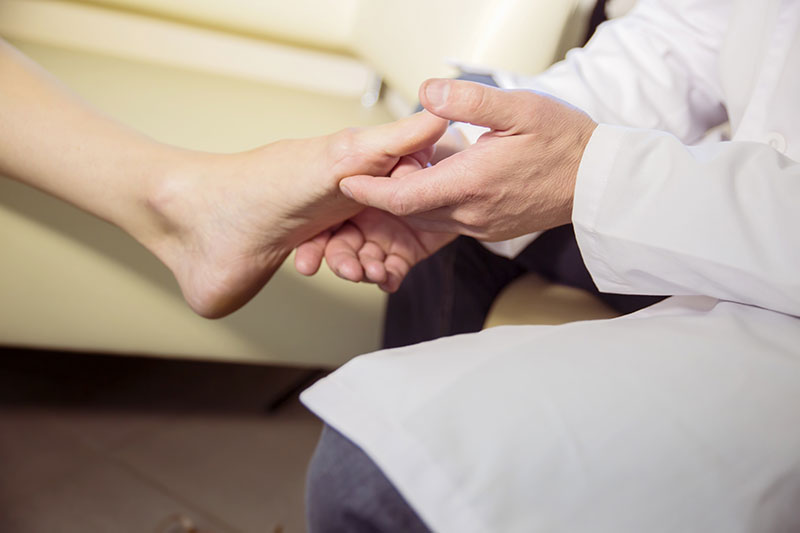
Meet our Bunion Specialist Surgeons
We are the UK’s leading cosmetic group and have some of the most experienced surgeons in the country working with us. Consultant general and Orthopaedic surgeon, Mr Bianchi joins us at our London Harley Street Bunion Clinic, Manchester Bunion Clinic and Bournemouth Bunion Clinic to offer consultations for the bunion correction and removal procedure.



